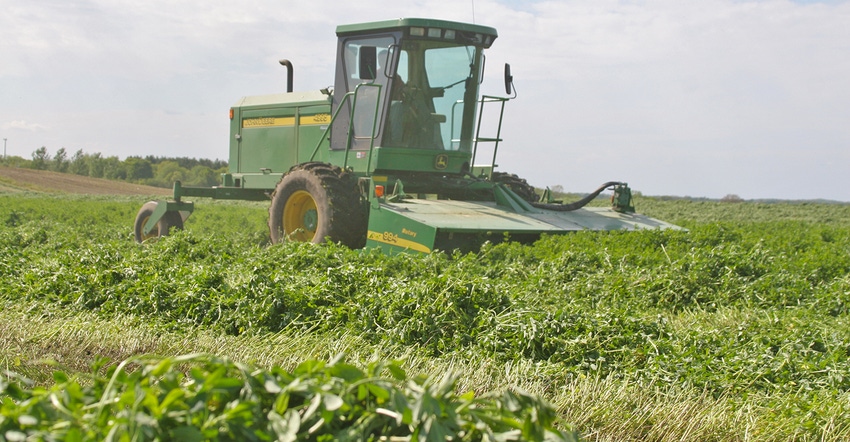September 5, 2018

By Bill Halfman
Discussions with cattle feeders about growing and finishing rations often revolve around corn silage, grain and coproduct feeds, such as distillers grains or other grain processing feedstuffs. I also often hear folks make comments that beef cattle do not need high-quality hay. While some classes of beef cattle don’t, there is a place for using high-quality, or “dairy quality,” alfalfa hay.
There is increasing interest in soil health and minimizing soil erosion these days, and a perennial crop in the rotation is a good thing for many farms. Alfalfa is a crop that will fit those soil health needs from a crop rotation standpoint, and will fit nicely into growing and finishing rations for feeding out cattle.
While making dry hay can be challenging, and even discouraging some years, alfalfa haylage will work at least as well as dry hay in growing and finishing rations. With advances in technology and techniques such as big bale silage, the risk of weather problems when making high-quality alfalfa feed is greatly reduced.
High-quality alfalfa hay or haylage complements corn nicely in growing rations for feeding out cattle. It is around 19% to 20% crude protein, 30% to 35% acid detergent fiber, and 40% to 45% neutral detergent fiber. Alfalfa is also an excellent source of calcium and potassium that fills in where corn is lacking regarding cattle nutritional requirements.
An example ration for growing cattle is 40% high-quality alfalfa, 59% corn and 1% supplement on a dry matter basis. This ration will provide about 53.6 Mcal NEg (megacalorie net energy for gain) per cwt of dry matter, 13.6% crude protein, and adequate calcium and potassium such that there should be no additional protein, calcium and potassium supplementation needed. Cattle should gain around 2.5 pounds a day on this ration for animals weighing 400 to 700 pounds. Aside from some trace mineral salt, this ration could be completely homegrown.
Finishing rations using high-quality alfalfa forage are not quite as straight forward as the growing ration in the previous example. Recommended finishing rations will have less roughage and higher energy. Ten percent to 12% roughage and around 62 Mcal NEg per cwt of energy is a good target to work toward for efficient finishing of cattle. Alfalfa can provide all the roughage and will reduce the need for purchased protein, but the ration will require some additional protein to meet animal requirements. Distillers grains or other protein sources can be used to make up the difference.
An example ration using high-quality alfalfa for finishing cattle would be: 10% high-quality alfalfa, 72% corn, 14% dried distillers grains with solubles, and 4% supplement pack for calcium and trace minerals and ionophores. Holstein steers on this ration should be able to gain at least 3 pounds a day depending on management.
In summary, don’t forget about using high-quality alfalfa in growing and finishing rations for cattle. The alfalfa can be beneficial from both cropping and nutritional standpoints. There can be harmony between farm-raised corn and alfalfa resources in the cattle feeding enterprise.
Halfman is the Extension agriculture agent in Monroe County, Wis. This column is provided by the University of Wisconsin-Extension’s Wisconsin Beef Information Center.
You May Also Like




